#c: charles boyle
Text
B99 squad prompt
in episode 5, they mention their oldest collar : 81 for Jake, 96 for Amy, 78 for Diaz and 50 year old twins for Scully. in episode 6, someone shagged a tree (don't ask me) and Scully asks if it was a maple, so maybe he can understand someone wanting to shag a tree if it's a maple because he caught someone doing it at some point. so, combining that with the Rosa undercover in an old people home prompt (somewhere on my blog), a series of fics about their oldest collar, wherein Rosa's is in a home, Jake's is the drug dealer from the episode, we get to see Amy's arrest of the geriatric flasher, and Scully's oldest collar is two 50 year olds doing weird shit to a tree. also, might include Charles' oldest, a 68 year old. what he did with them is a spoiler for the episode.
#the-c-odd-prompt#brooklyn 99#rosa diaz#amy santiago#jake peralta#scully#dont know his first name sorry#charles boyle#...i think it's michael#is it michael??#codd-sequel
13 notes
·
View notes
Text
Alphabetical Character Encyclopedia
Here is the Alphabetized character encyclopedia. There will be spoilers throughout, so read at your own discretion.
Chronological encyclopedia
Master Post
A
Abezithibod
Abraham Van Helsing
Achasiah
Adam Frankenstein
Adelaide Sallow
Alfonso Pari
Amadeus Briggs
Amanda Briggs
Amon, Duke of Hell
Andelin Sylvia Lillemor Lindbek
Antares Briggs
Antonio Pari
Aoife Crawford (ULTRAMagic Devil)
Asclepius, Son of Hermes
Athena
Auda Willfort
Aureolus Schindewolf (ULTRAMagic Disciple)
B
Barna Schindewolf
Barry Esko Boyle (ULTRAMagic Hunter)
Baphomet
The Beast of Old
Beauregard
Berislav Briggs
Bethony Briggs
Bileth, King of Hell
Blood-Wraith Raynot
Boris
Brendan Devilfay
Brenna Thompson
Bronislav
Spiritus Magni Brutus
King Brutus IV
Buster Ash
C
Caius
Carol the Traveler
Charles Blackwell Ford
Chernobog
Claudius Alfieri
Cliff
The Conspirator of Old
Cordelia Willfort
Corentin Schindewolf
The Crimson Abyss
Cronus (ULTRAMagic Reaper)
D
Daniel
Saint Darkborne
Darkness
David Livesey (ULTRAMagic Magistrate)
Deimos (The Mage of Old)
Desislav Robles
Dionysus, Lord of Madness
Dolus & Iocus
Donia
Dragoslava Raynot
Drazhan Thornefield
Drusa
Dunja Schindewolf
E
Ekaterina
Elaine Gabriella O'Nessie
Eleanor
Duke Eligio Moretti
Ellen the Wayward
Empress Eliza-Rex/Eloise
King Englehart Schindewolf
Erika Storm
Dr. Ethan Luminate
The Evangelist of Old
Ex
F
Fausta Dracul
Faustus
The Fear of Old
Fenrir
The Forest of Old
G
Gabriella Pari
Gilgamesh, King of Uruk
The Great Unspeaker
Gratiana Arlotti
Grendel Bombastus Scarfe
Gustav
H
Hades, Lord of the Underworld
Heinrik Rofocale
Herman Lydon
Hermes Trismegistus
The Hunger of Old
The Hydra of Old
I
Ignatius Darren Ford (ULTRAMagic Infinity)
Inferno
K
Katsuko Yoshinaga
Kresimira Raynot
Kyu #9
L
Lance
Leif/Tyrant (The Dragon of Old)
Leonardo Hammond O'Nessie
Logan Bonneville
Loki
Lucifuge Rofocale
M
The Madman of Old
Marion "Tanya" Devilfay
Mary Pickford
Maya Athenon
Mayhem
Maxima
Maximus Raynot (The War Machine of Old)
Mazatl Nakahara/Adrien Irons
Mercurius II
Milosh Proch
Mira
The Monolith of Old
Morana Dracul
Morrigan Devilfay
N
Nathaniel "Haunt" Fernsby
O
Octavia
Octavius
Odin
Sir Odo, Knight of the Unlight
Olivia Briggs
Orion
Ornias
P
Persephone, Lord of Darkness
Proteus (The Ocean of Old)
R
Duke Radovan Raynot
Raguel
Randalph Theoprastus Scarfe
Rebis
Regnault
Dr. Reynard Woodall
Richard Callahan/Rostislav Dracul (ULTRAMagic Richter)
Captain Roger/Manius
Duchess Rose Raynot
Ryota Tsukumo
S
Saul Bonneville
Seishin Mikoto
The Screaming God
Shigeko Tsukumo
Chief Sigmund Willfort
Six-Eared Macaque
Skari Willfort
King Sten Haugen
Stolas, Prince of Hell
Stolon, Duke of Hell
Sun Wukong
T
Theobold
Thor
Thora Willfort
Thunder
Timothy Finnegan
Torunn Craddock
Trevor MacQuoid
Trumna Wintergate
Tusk Willfort
U
ULTRAMagic Ultimatum
Umbra
V
Valentina Pari
Vexation
Victor Von Frankenstein
Vlad III Dracula
Vlad IV Dracul
Vladislav Velimir Dracul
Vlastimir Bartholomew Dracul
W
Walter Nithercott/ ULTRAMagic Walker
The Watchman of Old
Weaver Craddock
Wilhelm
William Ford II (ULTRAMagic Shadow)
Sir Wolfgang
Z
Zal-Rint
Zoltan Tenebrae Raphael Dracul
1 note
·
View note
Text
Jacques Alexandre César Charles

Portrait by Adélaïde Labille-Guiard
November 12, 1746 – April 7, 1823 was a French inventor, scientist, mathematician, and balloonist. Charles wrote almost nothing about mathematics, and most of what has been credited to him was due to mistaking him with another Jacques Charles, also a member of the Paris Academy of Sciences, entering on May 12, 1785. He was sometimes called Charles the Geometer. Charles and the Robert brothers launched the world's first unmanned hydrogen-filled gas balloon in August 1783; then in December 1783, Charles and his co-pilot Nicolas-Louis Robert ascended to a height of about 1,800 feet (550 m) in a manned gas balloon. Their pioneering use of hydrogen for lift led to this type of balloon being named a Charlière as opposed to a Montgolfière which used hot air.
Charles's law, describing how gases tend to expand when heated, was formulated by Joseph Louis Gay-Lussac in 1802, but he credited it to unpublished work by Jacques Charles.
Charles was elected to the Académie des Sciences in 1795 and subsequently became professor of physics at the Académie de Sciences.

The balloon built by Jacques Charles and the Robert brothers
Charles conceived the idea that hydrogen would be a suitable lifting agent for balloons having studied the work of Robert Boyle's Boyle's Law which was published 100 years earlier in 1662, and of his contemporaries Henry Cavendish, Joseph Black and Tiberius Cavallo. He designed the craft and then worked in conjunction with the Robert brothers, Anne-Jean and Nicolas-Louis, to build it in their workshop at the Place des Victoires in Paris. The brothers invented the methodology for the lightweight, airtight gas bag by dissolving rubber in a solution of turpentine and varnished the sheets of silkthat were stitched together to make the main envelope. They used alternate strips of red and white silk, but the discolouration of the varnishing/rubberising process left a red and yellow result.
Jacques Charles and the Robert brothers launched the world's first hydrogen filled balloon on August 27, 1783, from the Champ de Mars, (now the site of the Eiffel Tower) where Ben Franklin was among the crowd of onlookers. The balloon was comparatively small, a 35 cubic metre sphere of rubberised silk, and only capable of lifting about 9 kg (20 lb). It was filled with hydrogen that had been made by pouring nearly a quarter of a tonne of sulphuric acid onto a half a tonne of scrap iron. The hydrogen gas was fed into the balloon via lead pipes; but as it was not passed through cold water, great difficulty was experienced in filling the balloon completely (the gas was hot when produced, but as it cooled in the balloon, it contracted).
Charles developed several useful inventions, including a valve to let hydrogen out of the balloon and other devices, such as the hydrometer and reflecting goniometer, and improved the Graves and heliostat and Fahrenheit's aerometer. In addition he confirmed Benjamin Franklin's electrical experiments.
Charles's law (also known as the law of volumes), describing how gases tend to expand when heated, was first published by natural philosopher Joseph Louis Gay-Lussac in 1802, but he credited it to unpublished work by Jacques Charles, and named the law in his honour.
Around 1787 Charles did an experiment where he filled 5 balloons to the same volume with different gases. He then raised the temperature of the balloons to 80 °C (not at constant temperature) and noticed that they all increased in volume by the same amount. This experiment was referenced by Gay-Lussac in 1802 when he published a paper on the precise relationship between the volume and temperature of a gas. Charles' law states that under constant pressure, an ideal gas' volume is proportional to its absolute temperature. The volume of a gas at constant pressure increases linearly with the absolute temperature of the gas. The formula he created was V1/T1 = V2/T2.
2 notes
·
View notes
Note
Omg ok so I have dreams with dsmp characters in them all the time and usually it's just them standing off to the side just kinda watching shit go down. (Unless it's ranboo. It is a reoccurring thing in my dreams for cc!ranboo to appear halfway through my dreams and do everything he can to sabotage whatever I'm doing. This usually ends in me dying and him laughing.) but my most recent dream was c!tubbo walking around with a gun in one hand and Michael in the other and killing people. He was killing people as a father son bonding activity, michael had a nerf gun that he carried around and shot squirrels with <3 meanwhile c!ranboo was in a tiny apartment (since c!ranboo is like 8'5 or smth he was comically cramped it was kinda funny to watch) and he was grieving tubbo and michael because he thought they died for some reason and he refused to leave the apartment but it's ok because charles boyle from brooklyn 99 brought him a sandwich so he wouldn't die. I'm pretty sure during all this I was at the store with my mother buying pastries. It was really disorienting because my dream kept switching perspectives between murderous tubbo, pathetic sad ranboo, and me. Another time I had a dream that I went to a birthday party for cc!ranboo even though in the dream I fucking hated him and I brought a bag of apples for some reason and my friend was like "oh cool you can give those to ranboo for his birthday! He plays minecraft so he loves apples."'and I was like fuck no and ate the entire bag of apples myself while ranboo cried. I think my subconscious might dislike ranboo. Just a bit.
JESUS CHRIST?????? okay ctubbo and michael deserve to bond like that i think though
6 notes
·
View notes
Text
Why Is The Actual Mass Flow Rate Important In Gas Flow Measurement?
Measurement of gas mass flow under process circumstances is never easy. To do it, there aren't many flow methods available, such thermal mass calorimetry and coriolis flow.Gas mass stays constant but gas volume changes in response to changes in temperature and pressure, according to Charles & Boyle's law. This is the primary justification for why it's crucial to determine actual mass flow rate during procedures.
First, let's examine the distinction between Standard and Actual Flow Rates.
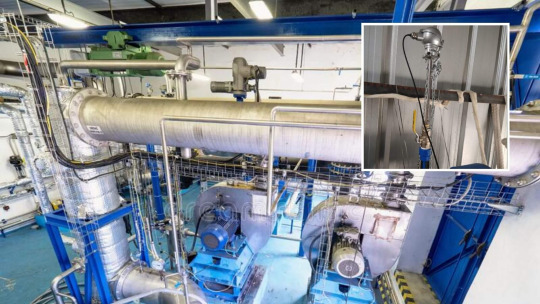
STANDARD FLOW RATES:
Standard flow rate is a flow rate of gas at specific pressure and temperature conditions. It is dependent on pressure and temperature conditions. It is termed as Standard volumetric
(Sm3/hr or SCFM) or Standard Mass flow rate (Kg/hr at specific standard conditions).
There are different standards conditions used internationally such as :
ISO2533 (1.01325bara @ 15°C );
DIN 1343 ( 1.01325bar @ 0°C);
Standard (1.01325bar @ 20°C) etc.
(above with 0% relative humidity conditions generally or sometime varying conditions )
ACTUAL FLOW RATES
Actual Flow rate is a flow rate of gas at different pressure and temperature conditions, It is independent of pressure and temperature conditions. It is termed as Actual Volumetric ( Am3/hr or ACFM ) or Actual Mass Flow Rate (Kg/hr at actual process conditions)
IMPORTANCE OF ACTUAL MASS FLOW RATE MEASUREMENT
As per Charles Law states that at constant pressure ideal gas volume increases with increase in temperature or gasses expands when heated.

And Bolye’s Law asserts that at a fixed temperature ideal gas volume is inversely proportional to pressure imposed on the gas. It suggests at constant temperature volume increases when pressure falls and gas volume decreases when pressure increases.
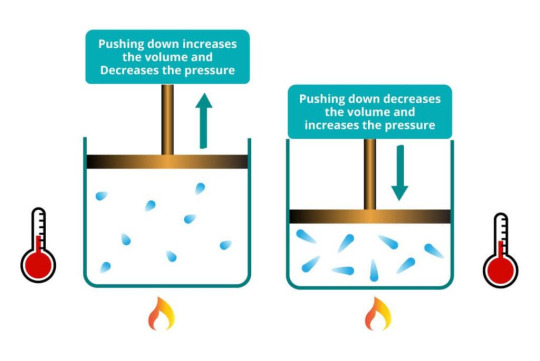
According to the aforementioned laws, measuring the volumetric gas flow rate results in a significant measurement inaccuracy because the volume of the gas changes as temperature and pressure do.
In order to accurately monitor and regulate the process conditions, we must ascertain the real mass flow rate of gas.
The Leomi 587 Insertion Thermal Mass Flow Meter for Actual Mass / Volume Flow Rate measurement was created with the process industry's actual need for precise and genuine measurement when improving process conditions in mind.
#thermal mass flow meter#compressed air#gas flow meter in india#compressed air flow meter#gas flow meter
0 notes
Text
Pre-Pilotage Notları - Genel Gaz Yasaları
İdeal (mükemmel) bir gaz, gaz yasalarına uyar. Aslında, hiçbir gaz gerçekten ideal değildir, ancak ses hızının yaklaşık %30'unda, düşük ses altı akışta ideal oldukları düşünülür.
Gazların kinetik teorisi (Bernoulli'den sonra Maxwell'den), gazların, özelliklerinin bağlı olduğu, sürekli hareket halinde olan moleküllerden oluştuğunu belirtir. Bir gazın hacmi, moleküllerinin serbestçe hareket edebildiği alandır. Aynı sıcaklık ve basınçtaki tüm gazların eşit hacimlerinin aynı sayıda molekül içerdiğini belirten Avogadro Yasasından (sayabileceğinizi varsayarak), aynı sayıda molekülün aynı hacme sahip olması gerektiği sonucuna varabilirsiniz.
Gazların kinetik teorisine katkılar şunları içerir:
Bir Fransız olan Jacques Charles'ın Charles Yasası, basınç sabit kalırsa, hacmin (ve yoğunluğun) mutlak sıcaklıkla neredeyse orantılı olduğunu, dolayısıyla bir gaz ne kadar sıcak olursa, o kadar fazla yer kaplayacağını veya daha küçük bir alana sıkıştırırsanız, daha sıcak olacağını ve bunun tersinin de olabileceğini öne sürer. Bir gazın sıcaklığını iki katına çıkarırsanız, hacmini de iki katına çıkarırsınız. Başka bir deyişle, farklı gazların eşit hacimleri, basınç sabit tutulursa aynı sıcaklıkta eşit şekilde genleşir, hacimdeki değişiklik 0°C'deki başlangıç hacminin 1/273'ü kadardır, sıcaklıktaki her derece değişim için, yukarı veya aşağı, yani -273°C'de hacim sıfır olacaktır. Bu yasa (ki zaten sadece yaklaşık olarak doğrudur) Charles'ın bir balonla ilk meteorolojik uçuşunu yapmasına ve yüksekliğini hesaplamak için bir barometre kullanmasına dayanmaktadır.
Dolayısıyla, İspanya ve İzlanda aynı basınca sahipse, İzlanda'daki hava daha yoğun olacak.
İrlandalı bir fizikçi olan Boyle, bir fizikçi için
mükemmel gazı', eğer sıcaklık sabit kalırsa (yani izotermal ise), hacmi (ve yoğunluğu) basıncı ile ters orantılı olarak değişecektir olarak açıklar, yani bir gazın basıncını iki katına çıkarırsanız, hacmini yarıya indirirsiniz. Tırmandıkça ve basınç azaldıkça, orta kulak, sinüsler, bağırsak, akciğerler ve dişler gibi çeşitli vücut boşluklarındaki gazların hacmi artar ve ağrı ve/veya rahatsızlığa neden olabilir.
'Sadece yaklaşık olarak yüksek basınçlarda. Boyle'un
ve Charles'ın kanunları sadece küçük aralıklarda doğrudur.
Eğer İspanya'nın her yerinde hava 25°C ise, hava yoğunluğu dağlarda sahildekinden daha alçaktır.
Dalton, bir gaz karışımının toplam basıncının, birbirleriyle kimyasal reaksiyona girmedikleri varsayılarak, karışımdaki her bir gazın uyguladığı kısmi basınçların toplamıyla aynı olduğunu söyler ki bu oksijen için geçerlidir. Başka bir deyişle, her bir gazın basıncı, bileşen oranına göre toplamın bir kısmına katkıda bulunur veya kendi başına yapacağı basıncın aynısını uygular ve karışımın toplam basıncı bunların toplamına eşittir. Bu, meteorologların belirli bir hava parselinde ne kadar su buharı olduğunu bulmalarını sağlar, ki eğer yerdeki bir gazın yapısını bilirlerse, herhangi bir irtifa için miktarları hesaplayabilirler.
Dalton'dan sonra, belirli bir yükseklikteki basınç 986 hektopaskal olsaydı, oksijenden kaynaklanan basınç 986'nın %21'i veya 207 hPa olurdu. Ortalama bir akciğer seti oksijeni 3 psi kısmi basınçta emer, bu da kanı doyurmak için yeterlidir. Atmosferdeki gazların toplam ve kısmi basınçları irtifa arttıkça azalır.
Gay-Lussac Yasası, hacim sabit tutulduğunda, sıcaklıktaki eşit artışların basınçta eşit artışlara neden olduğunu belirtir.
Her şey bir anda değiştiğinde, sırasıyla Boyle ve Charles yasalarını kullanmalısınız. Karışıma Gay-Lussac ve Avogadro'yu ekleyerek, sıcaklığı, basıncı ve yoğunluğu şu şekilde birbirine bağlayan Genel Gaz Yasası (Hal Denklemi olarak da bilinir) adı verilen tek bir ifade elde edebilirsiniz:
p = RTρ
ρ yoğunluk, T mutlak sıcaklık ve p basınç ve R, gaza bağlı bir sabittir (2.87 için kuru hava). Sabit elbette değişmez (gazı değiştirmediğiniz sürece) ve sıcaklık aynı kalırsa, basınç yoğunlukla orantılıdır' -daha fazla molekülü daha küçük bir alana sıkıştırarak basıncı artırdığınız için yoğunluk otomatik olarak artar. Basınç aynı kalırsa, sıcaklıktaki bir artış yoğunluğu azaltır. Böylece, basıncı ve sıcaklığı biliyorsanız yoğunluğu hesaplayabilirsiniz.
'Yoğunluk sabit kalıyorsa basınç ve sıcaklık doğru orantılıdır.
Formül şu şekilde de ortaya çıkacaktır:
PV = RT
0 notes
Text
WHY IS THE ACTUAL MASS FLOW RATE IMPORTANT IN GAS FLOW MEASUREMENT?
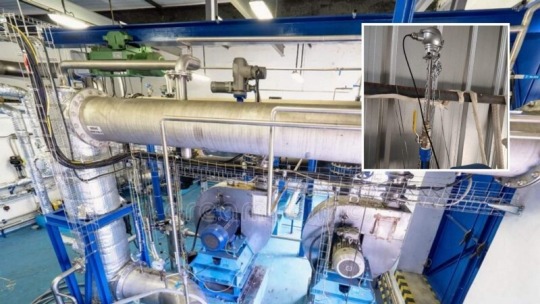
Gas mass flow measurement is always a challenge in process conditions. There are very few flow technologies available for achieving it such as Coriolis, Calorimetric ( Thermal Mass) etc..Gas volume varies with respect to temperature and pressure as per Charles & Boyle’s law but Gas mass remains constant. This is the main reason to measure actual mass flow rate is important to monitor in processes.
Let’s understand the difference between Standard & Actual Flow Rate first.
STANDARD FLOW RATES
Standard flow rate is a flow rate of gas at specific pressure and temperature conditions. It is dependent on pressure and temperature conditions. It is termed as Standard volumetric
(Sm3/hr or SCFM) or Standard Mass flow rate (Kg/hr at specific standard conditions).
There are different standards conditions used internationally such as :
ISO2533 (1.01325bara @ 15°C );
DIN 1343 ( 1.01325bar @ 0°C);
Standard (1.01325bar @ 20°C) etc.
(above with 0% relative humidity conditions generally or sometime varying conditions )
ACTUAL FLOW RATES
Actual Flow rate is a flow rate of gas at different pressure and temperature conditions, It is independent of pressure and temperature conditions. It is termed as Actual Volumetric ( Am3/hr or ACFM ) or Actual Mass Flow Rate (Kg/hr at actual process conditions)
IMPORTANCE OF ACTUAL MASS FLOW RATE MEASUREMENT
As per Charles Law states that at constant pressure ideal gas volume increases with increase in temperature or gasses expands when heated.
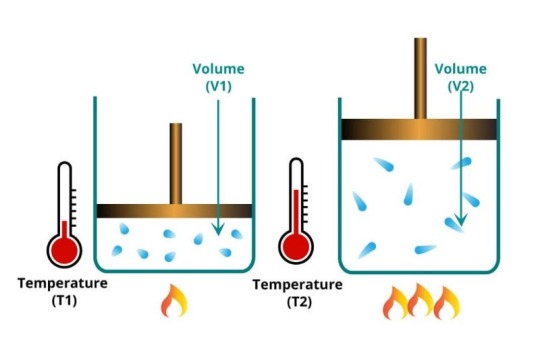
And Bolye’s Law states that at a constant temperature ideal gas volume is inversely proportional to pressure applied on the gas. It implies at constant temperature volume increases when pressure decreases and gas volume decreases when pressure increases.
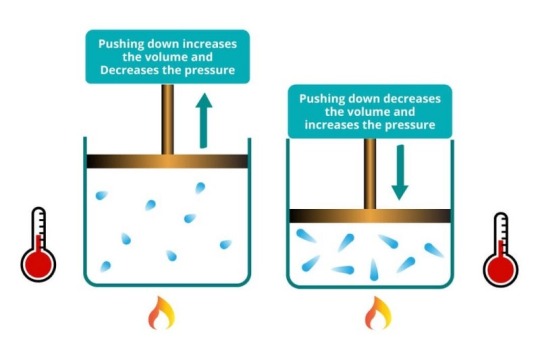
From above laws we understand that measuring volumetric gas flow rate gives a huge measurement error due to the fact that gas volume varies with changing temperature & pressure conditions.
Therefore, we must measure the actual mass flow rate of gas for an accurate measurement for controlling the process conditions.
Leomi 587 Insertion Thermal Mass Flow Meter for Actual Mass / Volume Flow Rate measurement is developed considering the process industry’s real requirement for optimizing process conditions with accurate and real measurement.
MORE INFORMATION www.leomi.in
0 notes
Text
Canto di natale dickens per bambini pdf
CANTO DI NATALE DICKENS PER BAMBINI PDF >>Download (Descargar)
vk.cc/c7jKeU
CANTO DI NATALE DICKENS PER BAMBINI PDF >> Leer en línea
bit.do/fSmfG
Nicholas Nickleby. eNewton Classici por Charles Dickens. EBOOK. Con una premessa dell'autore Cura e traduzione di Riccardo Reim Edizione integrale Nicholas Outreach Programme on the Holocaust is a broad initiative to educate and raise sensazionali e il mondo del teatro con il “Canto di Natale” di Dickens.EDIZIONI PAOLINE Bosca Francesca IL VASAIO DI GERICO EDIZIONI PAOLINE Bottaro Luciano PINOCCHIO A FUMETTI SAN PAOLO Boyle Alison I PERSONAGGI DEL NATALE Listado de todos los Recursos de la Biblioteca de la EOI ELCHE A SHORT HISTORY OF PRIVATE LIFE. LITERAT.FICCION CANTO DI NATALE. LITERAT.FICCION. Premio “Accademia Argentina delle Lettere” di merito per la media dei voti più alta. DICKENS, C., Una canción de Navidad, (Canto di Natale, 2017), por C Del Vivo · 2014 — 2012a), che narrano le vicende della guerra di Troia, e Il Natale di Roma (Orvieto, rato alle piccole avventure domestiche dei figli bambini, d'Aquino – attingere solo una parte, si trova anche nel canto XXIII del semplice, quella dei bambini, del cuore e non della ragione. Funge da. Materia IBIC DSY - Letteratura per bambini e ragazzi, storia e critica: studi generali Data di pubblicazione: Ottobre 2019 Comitato scientifico Anna Ascenzi
https://www.tumblr.com/soxudawame/698162212203823104/combine-pdf-files-into-one-for-online, https://www.tumblr.com/soxudawame/698162212203823104/combine-pdf-files-into-one-for-online, https://www.tumblr.com/soxudawame/698162309091213312/vampire-20th-anniversary-edition-the-dark-ages, https://www.tumblr.com/soxudawame/698162212203823104/combine-pdf-files-into-one-for-online, https://www.tumblr.com/soxudawame/698162212203823104/combine-pdf-files-into-one-for-online.
0 notes
Text
297 pound hay budden anvil

W., Petersham 78 Collin B., Alburyħ9 Collins Wm., Narrabri 80 Condon P., BurkeĨ2 Constable H., Broken Hill 83 Conroy M., Broken HillĨ4 Conway Mrs. J., Broken Hill 67 Clifford C., Petershamħ1 Clugston Miss B.} East Orange 72 Cockroft J., Petersham 73 Cohen R., Leichhardtħ4 Cole Mrs. D., GoulburnĦ3 Clemens W, F., Mogil Mogil G4 Clement E., Bourke (2)Ħ6 Clement W. Petersĥ1 Choice J., Burta Station 52 Christie C., Moulameinĥ3 Christmas Miss M., Camperdown (2) 55 Clanay P., Cootamundra 56 Clark A, Booligalĥ7 Clark G., Moinbria Station 58 Clark G., Hillston (2)Ħ0 Clark John, Broken Hill 61 Clark T, Cochrane Creek 62 Clark W. Wm., Deniliquin 48 Chii Wa, GranvilleĤ9 Child Mrs. W., Summer Hill 45 Charles W., Grongroe Station 46 Charlton Wm., BourkeĤ7 Chicken, Mrs. W., Narrabri 38 Cemm Joseph, Newcastle 39 Chaboty M., AnuandaleĤ0 Chambers H. P., Narrandera 22 Carne H., NarramineĢ4 Carr John, Gunbar Station 25 Carr T., DeniliquinĢ7 Carroll T.„ Milroy Station 28 Carson Jas., Silverton 29 Carter James, Bourkeģ0 Cartwright C., East Maitland 31 Carver Wm, Rand wickģ2 Casey J., Woowooma Station 33 Caskey John, Broken Hill 34 Castle A., Gulgong 35 Castle C., Grenfellģ7 Cavauougli D. J., Newcastle 4 Callington F., Wentwerth 5 Callan Mr., Albury 6 Camell W., Bunnaħ Cameron A., Werai Station (2) 9 Cameron Alex., Cudgen Scrubġ0 Cameron A., Goolgumbla Station 11 Cameron D., Moamaġ2 Cameron D., Wentworth 13 Cameron John, Bourkeġ7 Campbell James, Weinteriga Station 18 Campion J., Sandy Creek Station 19 Carlson O., WilcanniaĢ1 Carmody J. M., Deniliquin (6) 150 Byrnes C., Tarcoolaġ CAIN James, Moorara Station 2 Callaghan Mrs. B., Broken Hill 142 Byass P., Broken Hillġ44 Byrne C. G., Parramatta Road 139 Butler H., Louthġ40 Butterson H., Frederickton 141 Byass P. W., Whittonġ30 Burke Walter, Oualy Station 131 Burn E., Mittagongġ32 Burns F., Bulgoo Station 133 Burrell W., Goodoogaġ34 Burt Harry, sen., Broken Hill 135 Burt James, sen., Broken Hill 136 Bushe Paul, Hillstonġ38 Butler Mrs. W., Uralla 123 Buckley Mrs., Randwickġ25 Bueckner F. E., Newcastle 119 Buchanan A., Balranaldġ22 Buckland C. C., Parramattaġ17 Bruck & Berry, Broken Hill 118 Bruss Capt. J., Broken Hill 113 Brown T., Silverton (2)ġ15 Brown W., Goolgambla Station 116 Bruce J. S., Loutliġ10 Brown Jno., Tweed Heads 111 Brown P., Broken Hillġ12 Brown W. C., Muhvala 107 Brown G, E., Deniliquin 10S Brown H., Joadja Creek 109 Brown J. J., Torrington 103 Brooken W., Newcastle 104 Brough Bros., Wilcanniaġ05 Brown Mr., Cudgen Scrub 106 Brown Mrs. W., Silverton 100 Brooks G., Granville 101 Brooks T., Pooncarieġ02 Broomfield Mrs. S., Cobham 94 Brindley J., Pooncarieĩ6 Broadbent James, Lcichhardt 97 Bromberg E., Br.okcn Hill 98 Brooke A. T., Broken Hill 87 Bree John C., Wollongong S8 Brennan C., Corowaĩ0 Brennan J, S, Mount Brown (2) 92 Brent Mr., Botany Bay 93 Briggs E. S3 Branfield W., Barringun 84 Bramwell John, BulliĨ5 Bray Mrs. A., Begaħ8 Boylan John, Leichhardt 79 Boyle D, Wentworth (2)Ĩ1 BrackenrigC. T, Broken Hill (2) 70 Bourke E., Hillstonħ1 Bowan W., Broken Hill 72 Bowden G., Pictonħ5 Bowen Mrs, G., Cockbum 76 Bowen G., Cockbum 76½ Bower G., Clifton 77 Boyce G.

0 notes
Text
30. Kinetic theory of gases provide a base for
30. Kinetic theory of gases provide a base for
(a) Charle’s law
(b) Boyle’s law
(c) Charle’s law and Boyle’s law
(d) None of these
Answer-c
View On WordPress
0 notes
Text
B99 missing ep prompt
we go from 1x10 Thanksgiving to 1x11 Christmas. There's space in there for more holidays or just Team Evenings. Mostly i just want Jake's turn at hosting a full-squad dinner-party type of thing, because we've seen Holt (casual posh) and Amy (neurotic chaotic) do it. or if it's not a holiday related, everybody sits for dinner kind of thing, then a board game evening, whatever, just everyone there and seeing how it goes.
#the-c-odd-prompt#brooklyn 99#jake peralta#amy santiago#rosa diaz#gina linetti#charles boyle#scully & hitchcock#ray holt#i want him to also bring#kevin cozner#terry jeffords#and mrs jeffords i guess#codd-sequel
8 notes
·
View notes
Photo
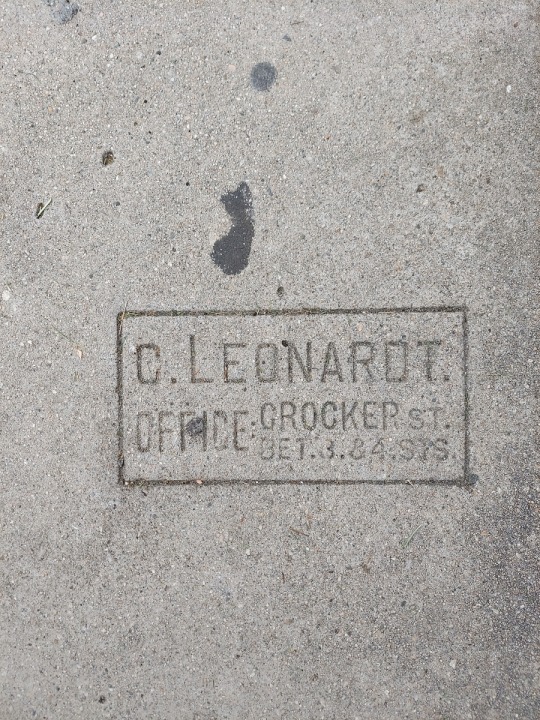
C. Leonardt. Office Grocker St. Bet. 3. & 4. STS (Photo taken by Sara Velas on May 27, 2022 on Norwood St. between 21st and Washington Blvd.)
I believe this photo is from the OpenUCLA Collections - Los Angeles Times Photographic Collection, but my notes got a little mixed up this time so am not sure.

Karl Heinrich was born in Luedenscherdt, Westphalia, Germany on March 27, 1855 and graduated with a degree in cement chemistry in Aachen, Germany. He married Anna Katharina Ballmann in Mannheim, Germany on September 20, 1883 (PCAD id: 3354). I am not sure when he anglicized his name to Carl. According to the Pacific Coast Architecture Database, Leonardt was 5′9.5″ with “blue eyes, black hair, and a light Caucasian complexion.” They apparently got this information from the California voter records of 1896. He became a naturalized U.S. citizen in 1890 in Los Angeles.
Before Los Angeles, he lived for a probably a couple years in Florida with his wife and then a year in San Antonio, Texas. They had three children: Amy Leonardt Powell (one source said her name was Emily), Clara Leonardt McGinnins, and Carl Adolph Leonardt.
He lived at 244 N. Breed Street in Los Angeles (Boyle Heights) from at least 1896 until 1900, according to voter records. I think this address is now part of the Breed Street Elementary School property.
The address in the stamp is near Los Angeles’s Little Tokyo.
He built many of Los Angeles’s notable buildings of his time, including the Los Angeles County Hall of Records #1 (demolished), L.A. County Courthouse, L.A. County Hall of Justice, Pacific Electric Building, Orpheum Theatre #3 (Downtown Los Angeles), Hotel Green (Pasadena), Hamburgers Building (last known as California Broadway Trade Center), and H. W. Hellman Building, plus the Ulysses S. Grant Hotel in San Diego. He also built “the sugar plants at Oxnard and Huntington Beach and many public and semipublic structures” (Los Angeles Herald article cited below). And, according to bridgehunter.com, Leonardt was the builder of the North Main Street Bridge concrete arch over the Los Angeles River on North Main Street in 1910.
In 1900, Leonardt was a director (and Vice President) of the Portland Cement Co. of Portland, Colorado, whose articles of incorporation were filed that year with the secretary of state. Already by this time, he was written up as having “had many years of practical experience in the manufacture and use of Portland cement, both in Europe and America” (Cement and Engineering News, Volumes 8-11, Cement and Engineering News, 1900).
In the same year, I see that he had something to do with the Pacific Technical Bureau for “‘Monier’ constructions,” but I can’t figure out what that means.
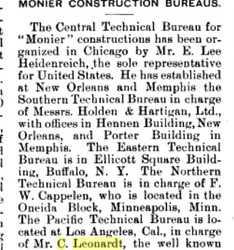
He was part of the “Reception Committee” for St. Joseph’s Church’s dedication in May 1903. Unfortunately, the church burned down in 1983. He’s the center photo in the top row of this collage (created by Charles C. Pierce, USC’s digital library).
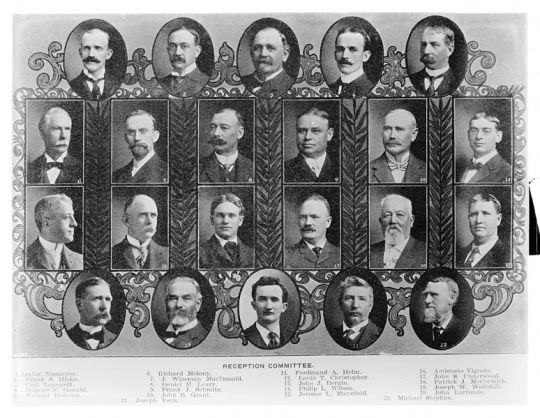
Albert C. Martin, perhaps one of Los Angeles’s most impactful architects, first moved out to Los Angeles in 1904 because he had received an offer “from Carl Leonardt to be superintendent of construction for Carl Leonardt and Company,” which was at the time one of the biggest construction firms in the city. Martin worked in that position for about a year (Gonzalez, Antonio. Architects Who Built Southern California, p. 6, Arcadia Publishing, 2019).
In 1906, his partners in his business were Frank Joseph Capitain and Edward Leodore Mayberry Jr. (PCAD).
In the same year, he gave a review on the restoration possibilities and likely costs for buildings that were damaged by the great days-long fires after the 1906 San Francisco Earthquake. Interesting that they went all the way to L.A. for the ‘expert’ here and that Leonardt was that man (Steel and Iron, Volume 78, National Iron and Steel Publishing Company, 1906). I think this is basically an ‘advertorial’ for steel construction.

In 1907, Leonardt won “the contract for the foundations of the new machine shops for the Santa Fe R.R.” and “for the erection of the roundhouse” in San Bernardino. I don’t think this is the current San Bernardino train station, which is quite beautiful but I believe was built significantly later. In the same year, he had the contract for a building in Phoenix, Arizona and a reinforced concrete depot, hotel, and roundhouse for the Atchison, Topeka & Santa Fe R.R. in Williams, Arizona (The Bridgemen’s Magazine, Volume 7, International Association of Bridge and Structural Iron Workers, 1907). The latter may be a part of the current Grand Canyon Railway system. Also during this year, Leonardt founded Southwestern Portland Cement, with corporate offices in Los Angeles but Division Headquarters in El Paso that covered plants in Odessa and Amarillo, Texas. They manufactured Portland cement from locally-quarried lime rock. He was president of Southwestern Portland Cement Company, at least as of 1918 (Los Angeles, California, City Directory, 1918, p. 1221). The company was acquired by Southdown, Inc. in 1971, long after Leonardt had died (El Paso Herald-Post, p. 48, July 5, 1976).
Around 1909, Leonardt was the principal in his own building contracting firm in Los Angeles. In this clipping from The Los Angeles Times on March 27, 1909, we learn of Leonardt’s connection to the Los Angeles City Market. And, this could perhaps be the context of the contractor stamp Sara found. Per the Chinese Historical Society of Southern California, “infighting amongst the shareholders and stall vendors led to the creation of two new markets in 1909; one was the City Market of Los Angeles on 9th Street and San Pedro, established by Mr. Louis Quan, while the other remained, in name, the Los Angeles Market Company, established on 6th Street and Alameda (the Southern Pacific railroad, wanting to run track through the 3rd and Central street location, exchanged this land for the lot on 6th street)” (Tara Finkle, “A History of the Los Angeles City Market, 1930-1950,” Gum Saan Journal, Vol. 32, No. 1, (2010), 24-38).

As of 1910, Leonardt was also an officer of Union Portland Cement Co (incorporated in 1906 in Utah “to mine cement and operate railways, etc” with a factory at Devil’s Slide, Utah) [p. 3061, “Industrials: General Balance Sheet”], Rice Ranch Oil Co (incorporated in 1904 in California with 6 producing wells in Santa Barbara County) [p. 3404, “Mining and Oil Companies”], The Colorado Portland Cement Co. (incorporated in 1901 in Colorado “for the purpose of manufacturing and selling Portland cement, cement plaster, lime, clay and all operations necessary in connection therewith”) [p. 3497, “Addenda”], and Acme Portland Cement Co (incorporated in 1908 in Washington “to manufacture and sell cement”) [p. 2402, “Industrials”] {Moody’s Manual of Railroads and Corporations Securities, Moody Manual Company, 1910].

In 1910, Leonardt’s only son died at 19 years old on West Adams Street “due to a blowout of a tire” that caused their automobile to “[turn] turtle into a ditch” (“Auto Overturns; Carl Leonardt’s Son Loses Life,” Los Angeles Herald, Volume 37, Number 314, 11 August 1910). He was home for the summer from Georgetown University. From this sad article, we also learn that Carl was a “millionaire contractor” who lived at “No. 2 Chester place,” which was in one of Los Angeles’s first gated communities. It was one of the most ‘hoity-toity’ neighborhoods - Edward and Estelle Doheny lived at 8 Chester Place as of 1901, but it became part of Mount St. Mary’s College starting with Leonardt’s #2 in 1962. He lived there until his wife died. For the remaining three years of his life, he lived with his daughter, Mrs. Frank Powell, at 687 S. Oxford Street. He had another daughter, Mrs. Felix McGinnis, in San Francisco, Ca.
As of 1913, Leonardt had become “one of the most famous contractors in the United States and one of the greatest constructors in the West.” I also like that the same article describes him as “rank[ing] among the most engrossed business men of [Los Angeles].” Around then he also “invested liberally” in oil development in California, “holding office and directorships in many of the more substantial oil companies” (”Los Angeles County Biographies: Carl Leonardt,” Press Reference Library, Western Edition. Notables of the West, Vol. 1, pg. 373, International News Service, 1913 transcribed by Marilyn R. Pankey on RootsWeb).
In the middle of that decade, Leonardt was involved in a lawsuit regarding the sugar warehouses he was operating and an insurance claim the insurance company felt they wouldn’t have had to pay if not for Leonardt’s wrongdoing. The courts sided with Leonardt but then with the insurance company on appeal (”Legal Decisions and Opinions: Storage Contracts--Actual or Implied,” Bulletin of the American Warehousemen’s Association, Volume 22, American Warehousemen’s Association, 1921). The publications describes this case as having “points of great importance to every warehouseman.”
I am not totally sure what’s going on here in 1915 but it seems like its probably illegal? (United States Federal Trade Commission. Report of the Federal Trade Commission on Price Bases Inquiry: The Basing-point Formula and Cement Prices, March, 1932. U.S. Government Printing Office, 1932.)

1918 was also a busy year for Leonardt & Peck! They were the contractors for James Benton Van Nuys, who owned “Lot 3, Block 24, Ord’s Survey” on South Spring Street. They completed the concrete building on February 6. Plans were filed April 4 for “new fronts, terra cotta work, concrete and brick partitions, etc. in banking rooms at southwest corner of Sixth and Main streets” for Hellman Commercial Trust & Savings Bank. Leonardt & Peck also had “a contract at about $4000 for constructing partitions and finishing the store room in the Morris Plan Bank building on South Spring street;” Morgan, Walls & Morgan were the architects and the Weber Showcase & Fixture Company were to install plate glass store fronts. At that time, I believe Van Nuys also owned this building (PCAD id 17373). They “secured another fine contract from the American Can Company” to build a “hollow tile service building... and a two-story reinforced concrete machine shop ... at the company’s plant in Vernon.” They had previously been the “builders of the original plant ... and subsequently erected a big warehouse and other structures.” As you can see by everything else I’ve written in this post so far but also in the “Who’s Doing It?” section of Southwest Builder and Contractor, Leonardt & Peck were one of the busiest contractors in Southern California (Volume 51, F.W. Dodge Company, 1918).

In 1919, there are a couple other potential origins of this particular contractor stamp Sara found! There are a couple options. One is that Leonardt wrecked a shed and a barn at 349 Crocker St., as listed in the October 31, 1919 issue on page 25. At this time, his office was in the H.W. Hellman Bldg, as part Leonardt & Peck, wreckers (which you may recall from earlier in this super long post that he built) (Southwest Builder and Contractor, Volume 54, Issues 14-26, 1919). This man has so many businesses! In November of that year, there’s another listing for 340-345 Crocker St., where Leonardt & Peck were to be ‘bldrs’ on brick stores.
In 1922, Leonardt & Peck appealed a case ruling in the Second Appellate District, Division one; Luella P. Jackson was the respondent. The case was regarding negligence in a “collision between automobile and concrete mixer.” Leonardt & Peck believed that a reasonable person would have noticed the mixer and that Jackson “in full daylight, ran into a corner of the hopper, which was attached to an arm of the mixer, thereby causing the hopper to break loose from its attachment and come down and rest on plaintiff’s machine .... failed to establish against defendant any negligent act authorizing a recovery.” I love that automobiles were routinely called ‘machines’ in the 1920s. The appellate court judge determined that “the negligence, if any there was, which produced the damage must be said to have been that of the drive of the automobile” (Reports of Cases Determined in the District Courts of Appeal of the State of California, Volume 57, Bancroft-Whitney Company, 1923).
In 1924, C Leonardt Improvement Company was incorporated as a “California stock corporation” with a “domestic state” of Nevada. It expired in 1971 (Bizapedia). They were part of a lawsuit in 1970 (Trade Cases, Commerce Clearing House, 1971).
In 1925, Leonardt built a ‘state-of-the-art’ cement plant in Ohio. It was designed by the company’s engineers based on ideas by Leonardt and a few others; it was also mostly built by their own company. In the same year, the Southwestern Portland Cement Co. “leased 2560 acres of gypsum deposits west of Alamogordo, N.M.” to build a gypsum plant (Rock Products: Devoted to the Production and Sale of Rock and Clay Products, Volume 28, Tradepress Publishing Corporation, 1925).
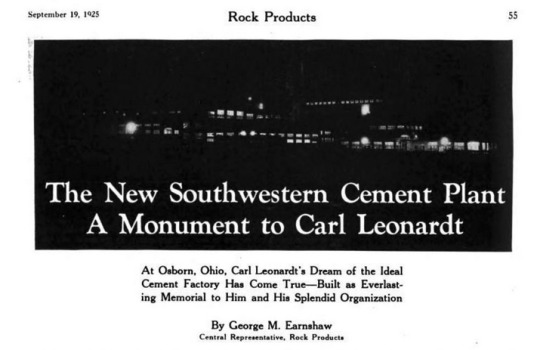
He died at age 71 after an operation for “abdominal trouble” at the Good Samaritan Hospital, after living in Los Angeles for forty years, on February 14, 1927. He was buried at Calvary Cemetery (a Roman Catholic cemetery in East Los Angeles, established in 1896). By the time of his death, “his company [had] plants in Victorville, El Paso, Tex., and Dayton, O.” The “honorary pallbearers” included many notable men of the time, including E.L. Doheny, Irving H. Hellman, Secondo Guasti, W. G. Kerckhoff, Isadore B. Dockweiler, and many others (”Carl Leonardt Answers Call,” The Los Angeles Times, February 12, 1927, p. 29).
His estate filed an appeal with the U.S. Board of Tax Appeals in 1928 (Reports of the United States Board of Tax Appeals, Volume 13, p. 1424, U.S. Government Printing Office, Nov. 2, 1928).
0 notes
Text
tired: sword in the stone
wired: lid on a yeast jar
10 notes
·
View notes
Photo
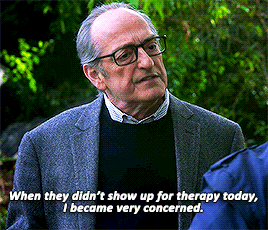





#b99edit#b99#brooklyn nine nine#jake peralta#charles boyle#tv: b99#c: jake peralta#c: charles boyle#mine
282 notes
·
View notes
Photo

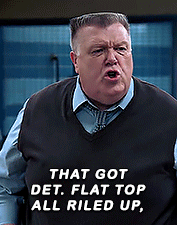



who do you think broke the vending machine

#who knows why he called terry a sgt not a lt#the set up#norm scully#charles boyle#terry jeffords#frank o'sullivan#b99edit#brooklyn 99#userives#usermacperalta#nessa007#userreeshika#userbrooklyn99#b99#john c mcginley#b99 guest stars#shaws#sitcomedit#filmtv#sitcom#b99rbsedit#chares x scully x terry#sleuth sisters#rosa diaz#amy santiago
300 notes
·
View notes
Text
WHY IS THE ACTUAL MASS FLOW RATE IMPORTANT IN GAS FLOW MEASUREMENT?
Measurement of gas mass flow in a process environment is usually difficult. Few flow technologies, including Coriolis, Calorimetric (Thermal Mass), etc., are available to do it.According to Charles and Boyle’s law, gas volume varies with regard to temperature and pressure whereas gas mass does not. This is the key factor in why it’s crucial to monitor the real mass flow rate in processes.
Let’s first clarify the distinction between Standard & Actual Flow Rate.
COMMON FLOW RATES
A standard flow rate is a gas flow rate at a particular temperature and pressure. Pressure and temperature conditions have an impact on it. It is also known as a standard mass flow rate (Kg/hr at particular standard conditions) or a standard volumetric flow rate (Sm3/hr or SCFM).
There are various worldwide norms and conditions, including:
ISO2533 (1.01325bara @ 15°C); DIN 1343 (1.01325bar @ 0°C); Standard (1.01325bar @ 20°C), etc. (above with generally or occasionally variable circumstances of 0% relative humidity)
ACTUAL FLOW RATES
Actual Flow rate is a flow rate of gas at different pressure and temperature conditions, It is independent of pressure and temperature conditions. It is termed as Actual Volumetric ( Am3/hr or ACFM ) or Actual Mass Flow Rate (Kg/hr at actual process conditions)
IMPORTANCE OF ACTUAL MASS FLOW RATE MEASUREMENT
As per Charles Law states that at constant pressure ideal gas volume increases with increase in temperature or gasses expands when heated.
Due to the fact that gas volume varies with changing temperature and pressure conditions, it is clear from the aforementioned rules that measuring volumetric gas flow rate results in a significant measurement error.
So that we can accurately monitor and regulate the process conditions, we must measure the real mass flow rate of gas.
The Leomi 587 Insertion Thermal Mass Flow Metre for Actual Mass / Volume Flow Rate measurement was created with the process industry’s true need for precise and real measurement optimisation in mind.
0 notes